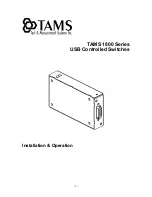
show ipv6 interface
60-11
60
This example displays a brief summary of IPv6 addresses configured on the switch.
Related Commands
show ip interface (59-4)
IPv6
IPv6 is marked “enable” if the switch can send and receive IP traffic on this
interface, “disable” if the switch cannot send and receive IP traffic on this interface,
or “stalled” if a duplicate link-local address is detected on the interface.
Link-local address
Shows the link-local address assigned to this interface
Global unicast
address(es)
Shows the global unicast address(es) assigned to this interface
Joined group
address(es)
In addition to the unicast addresses assigned to an interface, a node is required
to join the all-nodes multicast addresses FF01::1 and FF02::1 for all IPv6 nodes
within scope 1 (interface-local) and scope 2 (link-local), respectively.
FF01::1/16 is the transient node-local multicast address for all attached IPv6
nodes, and FF02::1/16 is the link-local multicast address for all attached IPv6
nodes. The node-local multicast address is only used for loopback transmission
of multicast traffic. Link-local multicast addresses cover the same types as used
by link-local unicast addresses, including all nodes (FF02::1), all routers
(FF02::2), and solicited nodes (FF02::1:FFXX:XXXX) as described below.
A node is also required to compute and join the associated solicited-node
multicast addresses for every unicast and anycast address it is assigned. IPv6
addresses that differ only in the high-order bits, e.g. due to multiple high-order
prefixes associated with different aggregations, will map to the same
solicited-node address, thereby reducing the number of multicast addresses a
node must join. In this example, FF02::1:FF90:0/104 is the solicited-node
multicast address which is formed by taking the low-order 24 bits of the address
and appending those bits to the prefix.
MTU
Maximum transmission unit for this interface.
ND DAD
Indicates whether (neighbor discovery) duplicate address detection is enabled.
number of DAD attempts The number of consecutive neighbor solicitation messages sent on the interface
during duplicate address detection.
Console#show ipv6 interface brief
Vlan 1 is up
IPv6 is enable.
FF01::1
2009:DB9:2229::79
FE80::269:3EF9:FE19:6779
FF02::1
FF02::1:FF00:79
FF02::1:FF19:6779
Console#
Table 60-2 show ipv6 interface - display description
Field
Description
Summary of Contents for Direk Tronik 24/48-Port
Page 2: ......
Page 4: ...ES4524D ES4548D F0 0 0 4 E112006 CS R01 149100030400A...
Page 22: ...xxii Tables...
Page 26: ...xxvi Figures...
Page 28: ...Getting Started...
Page 50: ...Initial Configuration 2 14 2...
Page 52: ...Switch Management Configuring Domain Name Service 29 1 Switch Clustering 30 1...
Page 68: ...Basic System Settings 4 8 4...
Page 118: ...Simple Network Management Protocol 11 18 11...
Page 142: ...Configuring 802 1X Port Authentication 14 8 14...
Page 154: ...Access Control Lists 15 12 15...
Page 232: ...Configuring Protocol Based VLANs 25 4 25...
Page 252: ...Quality of Service 27 8 27...
Page 282: ...Using the Command Line Interface 31 10 31...
Page 290: ...General Commands 33 6 33...
Page 300: ...System Management Commands 34 10 34...
Page 308: ...File Management Commands 35 8 35...
Page 326: ...Event Logging Commands 37 8 37...
Page 336: ...Time Commands 39 6 39...
Page 406: ...Access Control List Commands 44 18 44...
Page 418: ...Interface Commands 45 12 45...
Page 432: ...Broadcast Storm Control Commands 47 2 47...
Page 436: ...Rate Limit Commands 49 2 49...
Page 478: ...VLAN Commands 52 18 52...
Page 508: ...Quality of Service Commands 56 10 56...
Page 518: ...Multicast Filtering Commands 57 10 57...
Page 532: ...IPv4 Interface Commands 59 6 59...
Page 560: ...IPv6 Interface Commands 60 28 60...
Page 566: ...Switch Cluster Commands 61 6 61...
Page 568: ...Appendices...
Page 582: ...Glossary Glossary 8...
Page 587: ......
Page 588: ...ES4524D ES4548D E112006 CS R01 149100030400A...
















































